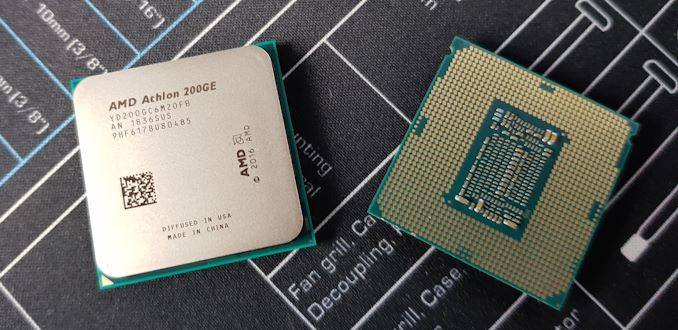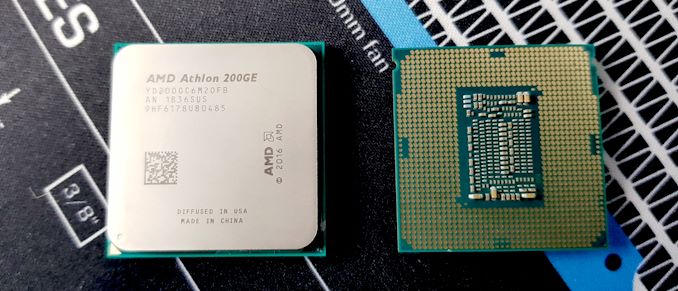The $60 CPU Question: AMD Athlon 200GE or Intel Pentium Gold G5400? A Review
by Ian Cutress on January 14, 2019 8:00 AM EST
In the course of our reviews, when we get a chance to get hands on with random processors, we run our test suite and add the data to our database. Sometimes that doesn’t materialize directly into a review, but at least we have the data. Two very similar CPUs have come across my desk recently: AMD’s dual core Athlon 200GE, and Intel’s Pentium G5400. Both chips round to the $60 mark, have some form of integrated graphics, and are aimed at budget systems.
This is going to be fun
One of the perennial issues with modern technology review cycles is that there’s a lot of focus on the high-end parts. These are the ones that the manufacturers sample: they have the highest margins, but are also the halo products: if they sit atop of the standings, then the hope is that that influence will trickle down into the rest of the product range, typically the high-volume parts. There is also the added benefit that more people want to hear about the best of the best. It’s a reason why there are so many Ferrari and Aston Martin ‘WOW’ pieces in written and video media.
Normally this would make sampling very difficult. If we were reviewing cars, anyway. The two chips in today’s analysis, the Intel Pentium Gold G5400 and the AMD Athlon 200GE, cost around $60 apiece, which I forked out for personally as I was never expecting to be sampled. (AMD asked if I wanted a 200GE sample two days after my retail unit arrived, go figure. I sent that on to Gavin for his 7-year old’s new gaming system.)
| AMD vs Intel at ~$60 | ||
| AMD Athlon 200GE |
Intel Pentium Gold G5400 |
|
| Cores / Threads | 2 / 4 | 2 / 4 |
| Microarchitecture | Zen | Coffee Lake |
| Motherboards | X470, X370, B450 B350, A320, A300 |
Z390, Z370, Q370 H370, B360, H310 |
| CPU Frequency | 3.2 GHz | 3.7 GHz |
| L2 Cache | 512 KB/core | 256 KB/core |
| L3 Cache | 2 MB / core | 2 MB / core |
| Integrated Graphics | Vega 3 192 SPs |
UHD 610 12 EUs (96 ALUs) |
| DDR4 Support | DDR4-2933 | DDR4-2666 |
| GPU Frequency | Up to 1000 MHz | 350-1050 MHz |
| TDP | 35 W | 54 W (2-core die version) 58 W (4-core die version)* |
| Price | $55 (SRP) | $64 (1k/u) |
| * Intel harvests both 2+2 and 4+2 dies to make G5400 parts. It's impossible to know which one you have without removing the lid and measuring the die area. | ||
When we stack up the two processors side by side, it gets interesting. Both are dual core, quad thread parts. The Intel processor has the frequency advantage, running at 3.7 GHz compared to the 3.2 GHz of AMD, but the AMD has beefier Vega 3 integrated graphics compared to the UHD 610 (GT1) graphics of the Intel chip. One sore point might be the TDP, where the AMD chip has a rating of 35W and the Intel chip is rated at 58W, however as we’ll see in the review, neither of them come close to those values.
Tackling the budget end of the market is fun. I’ve been a long-time advocate for budget builders to build a system piece-by-piece, getting one high-end part at a time rather than smearing a budget across several average parts at once. Under this philosophy, these processors could very well be the start of one of those builds, only costing an average of $60 MSRP. Note that under this philosophy, you might end up with that big graphics card before a processor that can power it. We’re covering those benchmarks as well.
Before you click further, place your bets on who you think will win: the Intel Pentium Gold G5400, or the AMD Athlon 200GE?
Latest News: While neither processor is officially overclockable, since we tested for this article it was recently reported that MSI motherboards with certain BIOS versions will allow users to overclock the 200GE to ~3.9 GHz. I've asked Gavin to contribute, and he managed a nice 3.9 GHz over the 3.2 GHz base clock. Head over to page 21 for the details.
Pages In This Review
- Analysis and Competition
- Test Bed and Setup
- 2018 and 2019 Benchmark Suite
- CPU Performance: System Tests
- CPU Performance: Rendering Tests
- CPU Performance: Office Tests
- CPU Performance: Encoding Tests
- CPU Performance: Legacy Tests
- Gaming: Integrated Graphics
- Gaming: World of Tanks enCore
- Gaming: Final Fantasy XV
- Gaming: Shadow of War
- Gaming: Civilization 6
- Gaming: Ashes Classic
- Gaming: Strange Brigade
- Gaming: Grand Theft Auto V
- Gaming: Far Cry 5
- Gaming: Shadow of the Tomb Raider
- Gaming: F1 2018
- Power Consumption
- Overclocking
- Conclusions and Final Words











95 Comments
View All Comments
perdomot - Saturday, January 19, 2019 - link
How does the author of this article not know that the price of the G5400 is in the $120+ range? At that price, the 1300x would be the appropriate comparison and it clearly smokes the Intel cpu in the benches. The author needs a reprimand for this poor work.mito0815 - Thursday, January 24, 2019 - link
Oh ffs. Been a while since I was around, and OH WOULD YOU LOOK AT THAT, the AMD shilling and -fanboyism in the comments has become just as unbearable as I'd imagined. People, he set up two budget CPUs on a comparable level (AMD strong in GPU, Intel a tad bit stronger in CPU performance & clock) against each other...nothing more, nothing less. Store prices for Intel CPU's being so inflated isn't really Intel's fault now, is it? The intended stock prices are still very much comparable. By your logic, AMD would've not been quite the price/performance god you all worship during the mining GPU price explosion now, would it?But no, all you guys want is an article with some AMD CPU coming out on top, no matter how it's done. Get over yourselves. By the looks of it, while GPU is still a sore point with AMD, Ryzen 2 seems to look good so far. Wait for that and don't go all rampant now.
kkilobyte - Saturday, January 26, 2019 - link
The article title starting with: "The $60 CPU question", it is not unreasonable 'fanboi-ism' to expect that the article is comparing CPUs costing, well, around $60.And the issue is not about Intel being guilty or not of the current high prices.
The problem is that the article draws conclusions that simply don't match reality, precisely because it doesn't adress the current discrepancy between the street prices and the manufacturer's suggested one. It would have taken a single paragraph to explain that.
My issue about the article is that, unlike what you are writing, it doesn't compare CPUs of similar (price) level. What it does is comparing CPUs of similar *theorical* price levels, but draws a conclusion as if those were the commonly seen street prices. This is dishonest and misleading.
watersb - Saturday, February 9, 2019 - link
Thanks for this review. I usually build low-end systems (PCs for family members), buy off-lease enterprise stuff (test servers), or used Apple or Lenovo gear (rebuilds and workstation projects).Budget gamng gear for the kids, then help them upgrade graohics card later, seems to be the one remaining path to "gaming enthusiast" hobby.
Everyone else gets a Chromebook. And a Raspberry Pi.
Dr Hasan - Tuesday, November 26, 2019 - link
Why are all products are old and prices too. Athlon 3000g is 50$ rayzen 2200g is less than 100$